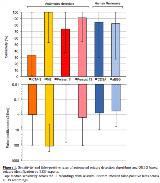Evaluation of Automated Seizure Detection Algorithms in Critically Ill Children
Abstract number :
2.030
Submission category :
3. Neurophysiology / 3B. ICU EEG
Year :
2018
Submission ID :
502739
Source :
www.aesnet.org
Presentation date :
12/2/2018 4:04:48 PM
Published date :
Nov 5, 2018, 18:00 PM
Authors :
Farah Din, The Hospital for Sick Children; Saptharishi Lalgudi Ganesan, The Hospital for Sick Children; Tomoyuki Akiyama, The Hospital for Sick Children; Craig P. Stewart, The Hospital for Sick Children; Ayako Ochi, The Hospital for Sick Children; Hiroshi
Rationale: Increasing awareness about non-convulsive seizures has led to a growing demand for continuous EEG monitoring in pediatric intensive care units. Quantitative EEG (QEEG) tools such as amplitude-integrated EEG (aEEG) and color density spectral array (CDSA) can help EEG experts quickly and efficiently screen prolonged EEG recordings for seizures. With most North American centers lack round-the-clock neurophysiologist review, automated seizure detection algorithms built within proprietary EEG monitoring systems could facilitate timely detection of seizures. However, there exist gaps in our understanding of how QEEG tools perform in comparison to the automated detection algorithms. Hence, we wanted to compare the performance of commercially available computerized seizure detection algorithms with QEEG-based seizure identification by EEG experts. Methods: Nineteen EEG recordings, 11 of which contained 379 seizures, recorded from a representative cohort of critically ill children were reviewed by a board-certified neurophysiologist who marked the beginning and end of all seizures as per standard criteria. We then processed these 19 EEG recordings using the default settings of four proprietary computerized seizure detection algorithms: ICTA-S, NB (Newborn), Persyst11 (P11) and Persyst13 (P13). The EEG recordings were also transformed to aEEG and CDSA trends. Following a 2-hour QEEG training session, three neurophysiologists and three EEG technologists independently marked all ‘suspected’ seizures on these QEEG trends using a digital review software. We calculated sensitivity for seizure identification and the false-positive rate (per 24-hour day) for each modality in comparison with seizures identified by the board-certified neurophysiologist on the raw EEG. Sensitivity was calculated on a per-recording basis and on a per-seizure basis for focal, hemispheric and bilateral seizures, and for short (<3 minute) and long (=3 minute) seizures. Results: The automated seizure detectors had a median (range) sensitivity of 33.3% (0 – 100) for ICTA-S, 100% (52.6 – 100) for NB, 74.1% (37.5 – 100) for P11, and 91.2% (0-100) for P13. Neurophysiologists and EEG technologists had a median (range) sensitivity of 84.6% (47.4 – 100) with CDSA and 82.4% (28.9 – 100) with aEEG for seizure identification (Figure 1). Sensitivity was greater for bilateral seizures in comparison to hemispheric or focal and long seizures compared to short seizures across all techniques. Median (range) daily false-positive rates were 1.00 (0.0 – 101.91) for ICTA-S, 115.10 (4.26 – 275.21) for NB, 0 (0.0 – 66.37) for P11, 1.54 (0.0-106.79) for P13, 0.78 (0.0 – 10.03) for CDSA, and 0.58 (0.0 – 5.33) for aEEG. Daily false positive rate was comparable among recordings with (11) and without seizures (8) for all modalities with a similar performance ranking. Conclusions: Sensitivity of some automated seizure detectors is approaching that of EEG experts using aEEG and CDSA; however false positive rates are generally higher and performance varies greatly among individual recordings. Our results suggest that automated seizure detection algorithms could complement the use of QEEG for continuous EEG monitoring and facilitate more timely seizure detection in critically ill patients; however, given the limitations of current techniques, confirmation of automated seizure detections by expert EEG readers would likely be required to inform optimal seizure management. Funding: No external funding was received for this research.
